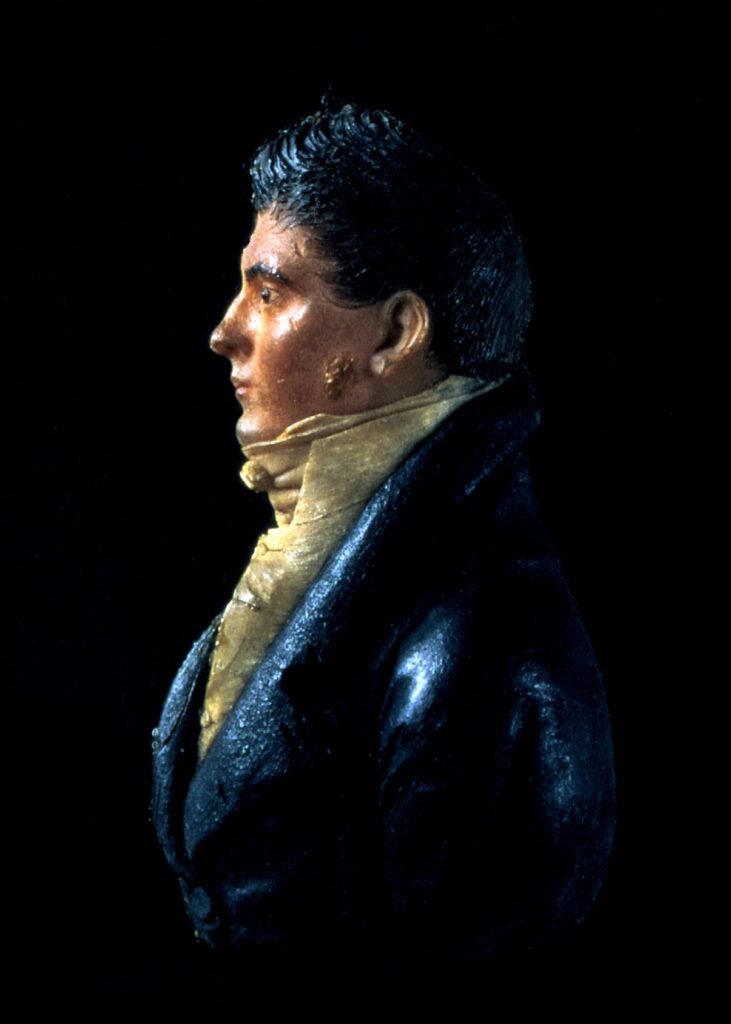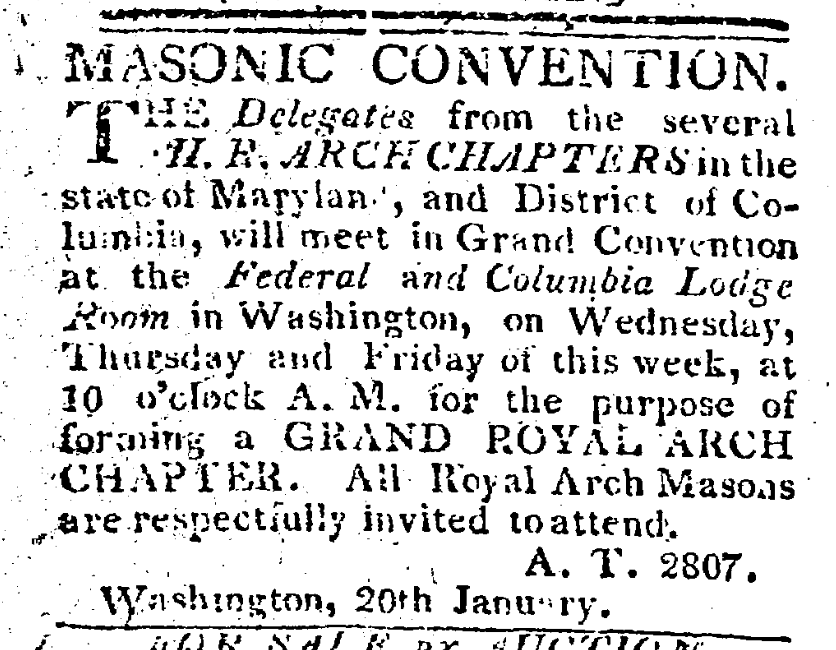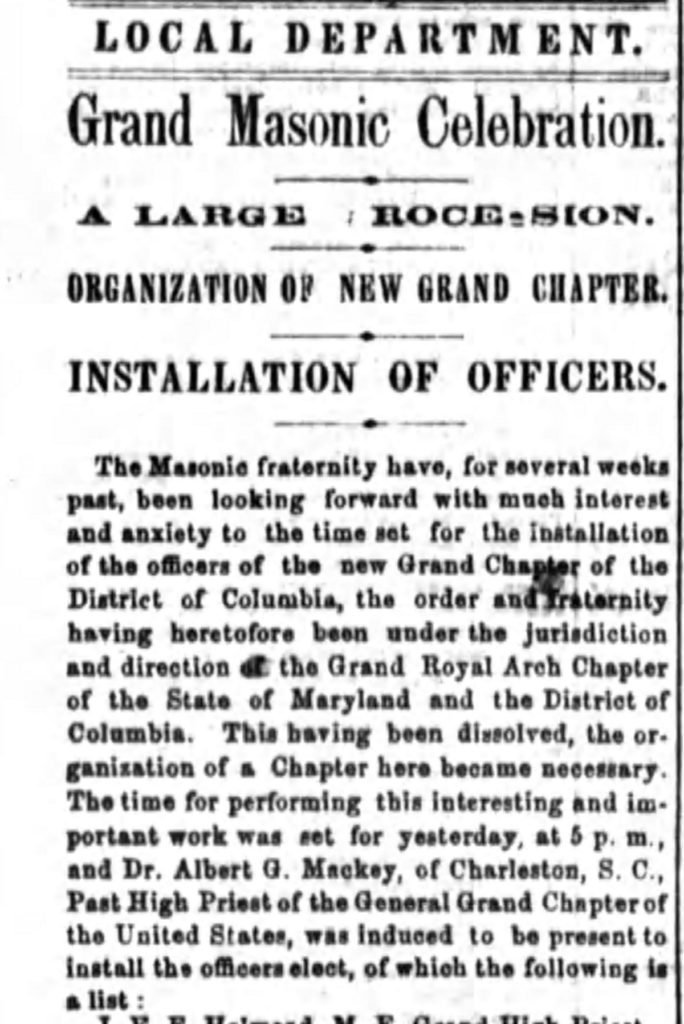History of the Grand Chapter
While the Grand Chapter is the oldest Masonic appendant body in Washington, Royal Arch Masonry began in the city much earlier, over seventy years earlier in fact, around 1795. The scraps of information we know about these early Royal Arch activities provide us with great insight into the history of Capitular Freemasonry and help us better understand the fraternity’s impact in Washington.
Origins

In September 1793, James Hoban and his Masonic colleagues working to build the White House and Capitol petitioned the Grand Lodge of Maryland for a charter to establish a new craft lodge in Washington. The Grand Lodge of Maryland maintained jurisdiction over the District until 1811, when Washington masons met to form their own Grand Lodge. Hoban’s request was accepted and they received a charter for Federal Lodge No. 15. Curiously, the charter also empowered them to open a Royal Arch Encampment in the city. The inclusion of an appendant body in a craft lodge charter suggests a more intimate connection between craft and capitular Masonry. This may have also been a function of convenience as the nearest appendant body in Maryland would have been a day’s ride to Baltimore.
Nevertheless, the Federal Lodge membership did not appear to be in a rush to organize the Royal Arch Encampment. The members met for the first time on December 14, 1795, more than two years after the lodge’s formation. Candidates paid $10, or $228 adjusted for inflation in 2022, to receive the Excellent Super-Excellent Royal Arch degree – the only degree offered by the Encampment that appears to be an amalgamation of our current Royal Arch, Super Excellent Master degrees. (Members of the Allied Masonic Degrees may find a connection here with the Excellent Master degree.) Net funds, after expenses, were to be “appropriated to a fund to the relief of distressed Brethren and for the Widows and Children of deceased Brethren.”
The Encampment met regularly until February 1799 when a resolution passed “that the Royal Arch Encampment be [broken] up.” They formed a committee to settle their affairs and split any remaining funds, which they referred to as dividends, amongst the companions. The membership included White House Architect James Hoban as their High Priest, Peter Lenox, a prominent and long-time member of the city’s Board of Alderman, as Third Grand Master now referred to as the Master of the Third Veil, White House stonemason Robert Brown as First Grand Master (Master of the First Veil), White House Chief Carpenter Pierce Purcell, and White House carpenter Clot Worthy Stephenson.
The record jumps several years to December 1st, 1804, which suggests that members revived the body with several names associated with the former encampment. They continued to initiate new members through the one degree until February 1807 when fees were updated so that new candidates now paid $2 for the Past Master Degree, $3 for Mark Master, and $10 for the Excellent Super-Excellent Royal Arch – a total of around $365 today, adjusted for inflation.
By the mid-1800s, Freemasonry grew at such a rate in the District that other craft lodges sought to form their own Royal Arch chapters. Two new chapters formed: Washington Naval Chapter through Naval Lodge No. 4 and Potomac Chapter through Potomac Lodge No. 5. Representatives from Federal, Naval, and Potomac chapters, along with three chapters from Baltimore met in Washington on January 21, 1807 to organize the Grand Royal Arch Chapter for the State of Maryland and the District of Columbia. Potomac chapter’s Valentine Reintzel, the future charter Grand Master of D.C., became Grand King while Federal Chapter’s Alexander McCormick became Grand Treasurer. Capitular Masonry remained tethered to Maryland until January 1824, when the District chapter’s withdrew to form the first Grand Chapter of the District of Columbia. This also meant that between 1811-1824, D.C. Royal Arch masons were under the jurisdiction of the Grand Lodge of D.C. for their craft lodge and a unified Maryland-D.C. influence for Capitular Masonry.

The First Grand Chapter

Formal discussions began on May 11, 1822. Representatives from Federal, Union, Potomac, and Brooke Chapters met in Brooke Chapter’s hall in Alexandria, Virginia. They agreed to publicly announce their intentions and meet in the Georgetown hall on June 15th to draft a Constitution and regulations.
The organization’s Constitution includes some notable points:
- The Grand Chapter’s annual communication was scheduled for the fourth Monday in November.
- Each chapter had a single vote. All Past High Priests, who served in the chair for at least six months, had a collective vote from each chapter. The Grand High Priest, Deputy Grand High Priest, Grand King, Grand Scribe, Grand Treasurer, and Secretary each had a vote. Past Grand Officers had one collective vote.
- Article 1, Section 11 forbade the Grand Chapter from issuing a charter for a Lodge of Most Excellent Masters, independent of a Chapter of Royal Arch Masons. This suggests that lodges existed merely to confer this “American” degree.
- Article 2, Section 1 defined Royal Arch Masons assemblies as a Chapter. While Mark Master and Most Excellent Master assemblies as a Lodge. There is no reference to the Past Master degree and it likely remained a blue lodge prerogative.
- The minimum degree fee for the Mark Master, Most Excellent Master, and Royal Arch was set at $15 or $380 when adjusted for inflation. The per capita assessment to the Grand Chapter was $.50 or $13 adjusted along with $1, or $25 adjusted, per candidate admitted or exalted during the year.
- A maximum of three candidates could be exalted during a Royal Arch degree conferral.
With their constitution and regulations set, representatives agreed to meet on November 25, 1822 to elect and install the organization’s officers. Curiously, the records jump two years to February 10, 1824. There is a small inscription at the bottom of the record that explains that the convention met “from time to time” but failed to secure a proper quorum until 1824. They secured a quorum on November 1824 and proceeded to elect Grand Chapter Officers. William Lambert, the sitting Grand Secretary of the D.C. Grand Lodge, was elected the first Grand High Priest. Lambert joined Freemasonry in Virginia and moved to Washington to lobby Congress to establish the American Prime Meridian. He secured President Monroe’s permission to perform astronomical observations and set up a temporary office at the Capitol to perform his evening observations. He served as Grand Secretary from 1823 to 1829.
The following day, February 11, 1824, Potomac Chapter 8 in Georgetown broke from the new Grand Chapter and announced that they planned to return to the GCMDC. Potomac’s members deemed it “inexpedient to separate” and would “not avail” itself of the permission and authority granted to join the new D.C. body. There is no additional reason provided as to why Potomac took this course of action but future communications suggest that Potomac’s representatives disagreed with the manner in which the new Grand Chapter conducted their proceedings. The chapter remained under the old grand body, which continued to call itself the Grand Chapter of Maryland and District of Columbia. This prompted the two grand bodies to exchange letters back and forth for the next several years to determine who had authority over the name and jurisdiction. The problem was eventually brought to the General Grand Chapter of the United States of America and a deal was struck so that Maryland would drop the “District of Columbia” in their name and acknowledge the District’s sovereignty in exchange for sole jurisdiction over Potomac Chapter. While the arrangement sounds peculiar, there is some precedent for Potomac’s decision. At the time, Alexandria-Washington 22 of Virginia declined to join the Grand Lodge of D.C., even though the city of Alexandria sat in the District of Columbia’s limits. The General Grand Chapter’s decision effectively capped this difficult moment between the District and Maryland Grand Chapters.


On January 26, 1826, Lambert installed his successor William W. Seaton as Grand High Priest. Seaton was a very prominent Washingtonian, publisher, and co-owner of the city’s largest newspaper the National Intelligencer. His print shop produced some of the District’s earliest masonic proceedings and notices. In 1828 Seaton led the Grand Chapter’s first major public procession in Washington city – a funeral procession and memorial service for New York Governor and General Grand High Priest DeWitt Clinton. He served as Grand High Priest for the next four years and improved relations with the Grand Chapter of Maryland. In December 1829, Seaton received word from the General Grand Chapter that Maryland and D.C. Grand Chapters were in charge of installing Edward R Livingston and Joel R. Poinsett as the new General Grand High Priest and Deputy General Grand High Priest, respectively. Both men were elected but had yet to be formally installed into their respective offices. With Livingston and Poinsett expected in Washington around January 1930, the General Grand Body asked Seaton and his counterpart from Maryland, J. K. Stapleton, to perform the duty. Due to conflict schedules and difficult travel, the installation did not occur until April 3, 1830. Seaton personally installed Livingston and Poinsett at the city’s Masonic Hall that day.
James Carson, of Brooke Chapter, succeeded Seaton as Grand High Priest in 1831. There is a noticeable decrease in activities during Carson’s administration and he is succeeded by John A. Cook in 1832. Again, few activities occurred between 1832 and 1833. Unfortunately, there are no records of the Grand Chapter’s activities from 1833 and 1842. On May 19, 1842, the District’s Royal Arch Chapters reunited with the Grand Chapter of Maryland to form the second iteration of the Grand Chapter of Maryland and District of Columbia.
This relatively brief period in Washington masonic history, which spanned only two decades, ends on a rather disappointing note. The District’s Royal Arch masons began this period with high hopes for a new masonic organization in Washington but their efforts ultimately failed to gain momentum. The District remained tethered to the Grand Chapter of Maryland and District of Columbia until March 26, 1867 when a new generation of masons, including prominent local figures like Benjamin B. French and Dr. Albert Mackey, the D.C. Grand Chapter that exists today.

Resurrection and Expansion
Lorem ipsum dolor sit amet, consectetur adipiscing elit. Ut elit tellus, luctus nec ullamcorper mattis, pulvinar dapibus leo.
